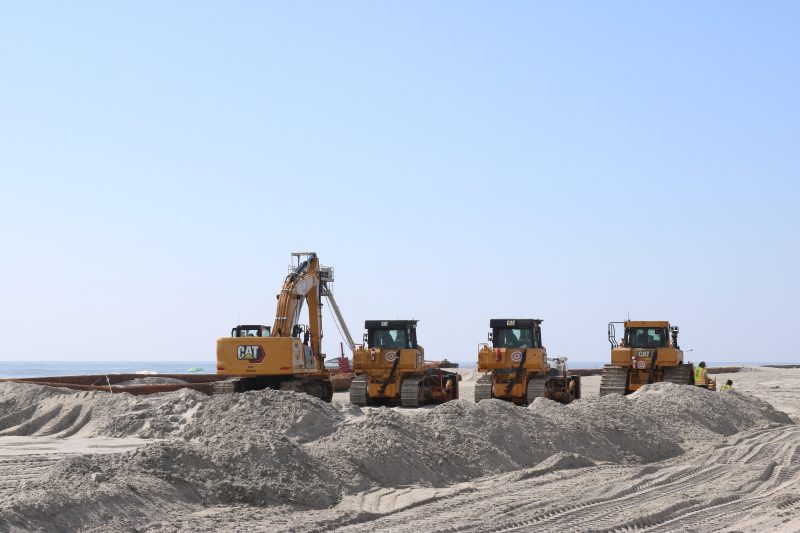
By DONALD WITTKOWSKI
Imagine a gigantic sock filled with sand and buried in the beach or dunes.
Well, you’ve pretty much got the idea of what a geotube is and how it looks.
Despite their decidedly low-tech design, geotubes are considered an important tool to protect shore communities from coastal storms – essentially acting as a bulkhead to block destructive waves from crashing ashore.
Now, Ocean City wants to add new geotubes to some of the beaches in the north end of town that are particularly vulnerable to the ocean’s wrath.
City Council is expected to vote at its meeting Thursday on authorizing going out to bid for the geotube project, city spokesman Doug Bergen said.
At the same time, the city is waiting for a permit from the New Jersey Department of Environmental Protection to build the project. The earliest Ocean City could expect a decision from the DEP would be December, Bergen noted.
“But we wouldn’t put out specifications and seek bids until we know the permit is approved. If all goes well, the geotubes could be installed in the spring,” he said in an email Tuesday.
Ocean City wants to piggyback on the U.S. Army Corps of Engineers’ recently completed beach replenishment project in the north end to protect the shoreline with geotubes. City officials have been focusing on the beach blocks of Fourth and Fifth streets, an area that gets hit hard by coastal storms.
Bergen explained that the beaches at Fourth and Fifth streets are exposed to the ocean’s waves and currents because of the shape of the island.
A bond ordinance approved last year by City Council designated $1 million in funding for geotubes in the area of Fourth and Fifth streets.

A beach replenishment project, now completed, has widened the city's north end shoreline.
Ocean City has already used geotubes to protect other vulnerable parts of the north end of the island.
When Hurricane Sandy slammed into the Jersey Shore in October 2012, it flattened the dune at Waverly Beach along East Atlantic Boulevard. However, the geotubes buried in the dunes there held back the ocean.
Bergen, in comments made last year, credited the geotubes for saving “a good bit of north-end property” during Sandy.
Since they are covered with sand, the geotubes can begin to resemble the natural dunes over time. Their construction consists of giant, sock-like cylinders made of plastic fabric and stuffed with sand. They are topped with dune grass after they are buried.
In addition to geotubes, Ocean City will be able to fortify the dunes in other ways. As part of the beach replenishment project completed this summer, the city created stockpiles of sand that will be used to rebuild the dunes at North Street, Fifth Street, 10th Street and other areas in need of additional sand, Bergen said.
Altogether, the replenishment project restored the beaches with 1.6 million cubic yards of new sand along a 2.1-mile stretch of Ocean City’s northernmost and downtown shoreline.

 A beach replenishment project, now completed, has widened the city's north end shoreline.
Ocean City has already used geotubes to protect other vulnerable parts of the north end of the island.
When Hurricane Sandy slammed into the Jersey Shore in October 2012, it flattened the dune at Waverly Beach along East Atlantic Boulevard. However, the geotubes buried in the dunes there held back the ocean.
Bergen, in comments made last year, credited the geotubes for saving “a good bit of north-end property” during Sandy.
Since they are covered with sand, the geotubes can begin to resemble the natural dunes over time. Their construction consists of giant, sock-like cylinders made of plastic fabric and stuffed with sand. They are topped with dune grass after they are buried.
In addition to geotubes, Ocean City will be able to fortify the dunes in other ways. As part of the beach replenishment project completed this summer, the city created stockpiles of sand that will be used to rebuild the dunes at North Street, Fifth Street, 10th Street and other areas in need of additional sand, Bergen said.
Altogether, the replenishment project restored the beaches with 1.6 million cubic yards of new sand along a 2.1-mile stretch of Ocean City’s northernmost and downtown shoreline.
A beach replenishment project, now completed, has widened the city's north end shoreline.
Ocean City has already used geotubes to protect other vulnerable parts of the north end of the island.
When Hurricane Sandy slammed into the Jersey Shore in October 2012, it flattened the dune at Waverly Beach along East Atlantic Boulevard. However, the geotubes buried in the dunes there held back the ocean.
Bergen, in comments made last year, credited the geotubes for saving “a good bit of north-end property” during Sandy.
Since they are covered with sand, the geotubes can begin to resemble the natural dunes over time. Their construction consists of giant, sock-like cylinders made of plastic fabric and stuffed with sand. They are topped with dune grass after they are buried.
In addition to geotubes, Ocean City will be able to fortify the dunes in other ways. As part of the beach replenishment project completed this summer, the city created stockpiles of sand that will be used to rebuild the dunes at North Street, Fifth Street, 10th Street and other areas in need of additional sand, Bergen said.
Altogether, the replenishment project restored the beaches with 1.6 million cubic yards of new sand along a 2.1-mile stretch of Ocean City’s northernmost and downtown shoreline.